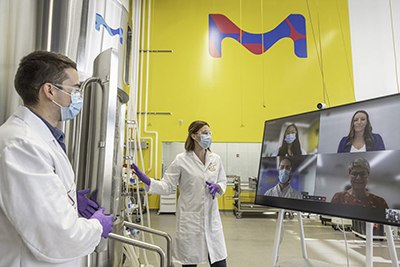Training & Education

Livestream lab course customer training
With more than 170 in-house certified trainers representing our global network of M Lab™ Collaboration Centers, we offer pharmaceutical and biopharmaceutical manufacturers a flexible way to enhance the skill sets of their people with practical, hands-on courses that can be attended in person or streamed live wherever you are. Our training and education options include:
- A wide range of biopharmaceutical courses, spanning upstream and downstream processing
- Classroom-style theory, or hands-on training tailored to your needs
- Focused training on the optimal use of our products, reducing your need for ongoing technical support
Browse Our Courses and Learning Plans
Own your future and learn new skills relevant to your work by exploring a wide array of webinars, videos, and e-learning courses at our e-learning portal, Learn@M.
Learn@M
Learn@M is an innovative e-learning platform developed by and for scientists, operators, and engineers. Whether you are researching the next scientific breakthrough in the lab, focusing on quality through rigorous testing, or optimizing a biopharma manufacturing process, you can now experience the innovative learning management system you need.
- Flexible, intuitive environment where scientists and engineers across industries and continents have 24/7 access to live and on-demand education.
- Personalized learning experience for technical experts by offering content recommendations for your individual educational journey.
- Live and on-demand accessibility gives you the flexibility to achieve your learning goals in any time zone and at your convenience.
- Access to learner communities and forums where you can network with your peers, share knowledge, and receive support.
- Includes a comprehensive library of micro learnings where you can consume content at your leisure to support and reinforce the knowledge gained from in-depth courses.
Learn@M is a platform that is constantly growing and evolving to support the advancements within the scientific community.
Related Resources
- White Paper: Workforce 4.0: The Long-Term Success of the Biopharmaceutical Industry
A public-private approach to workforce 4.0 development, transitioning from conventional factories to “smart” manufacturing facilities.
- eBook: Biopharmaceutical Training
Train your team to meet evolving industry needs.
- eBook: Welcome to the M Lab™ Collaboration Centers
Step into a global network of collaboration spaces for exploring cutting edge ideas and solving the toughest problems in life science.
- Transcript: Collaborate to Innovate
Shaping the future pharmaceutical manufacturing landscape.
Learn@M Courses
To continue reading please sign in or create an account.
Don't Have An Account?